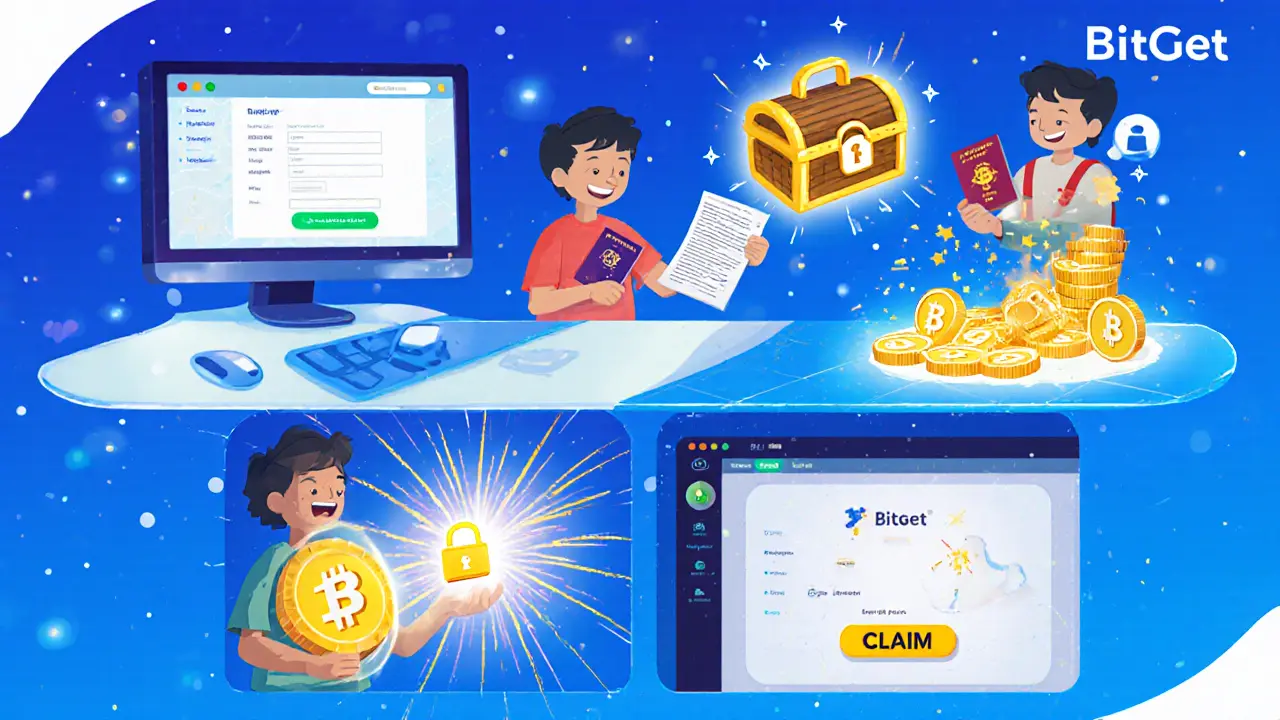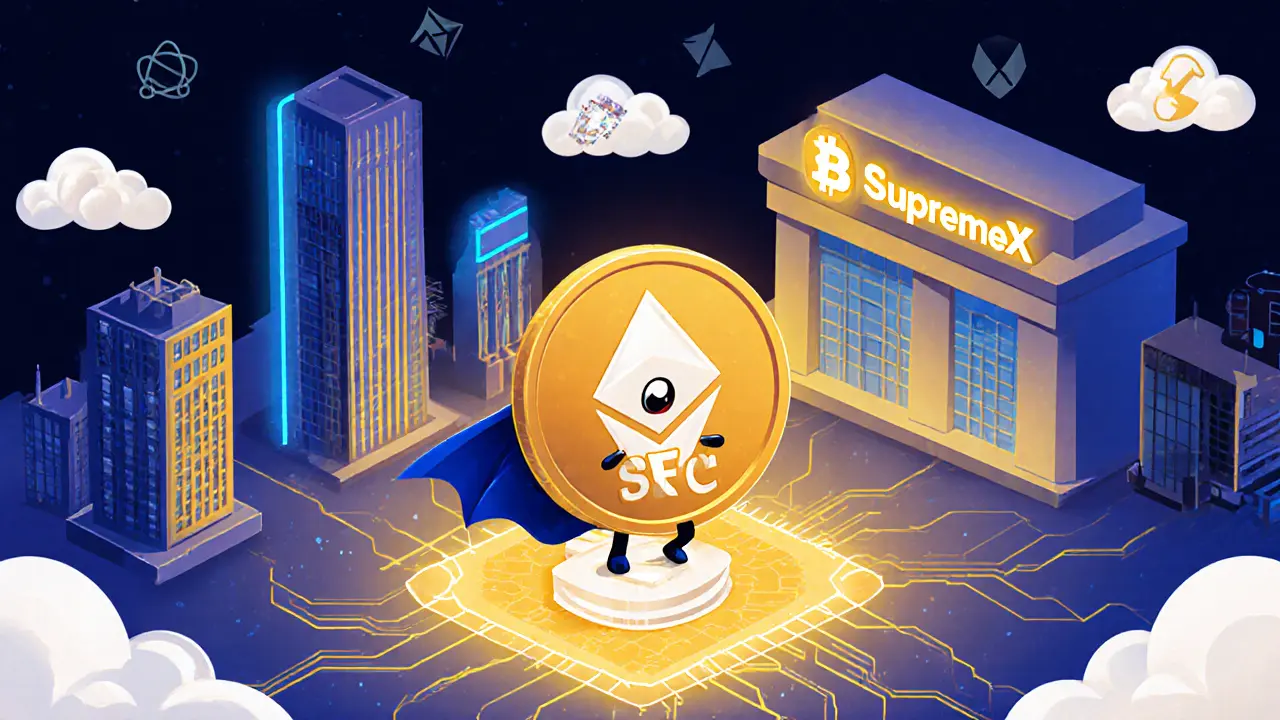SupremeX (SXC) Airdrop Calculator
Check if you qualify for the SupremeX airdrop based on your Bitget account status.
- Create a Bitget account with a unique email and enable 2FA
- Complete KYC verification with photo ID and proof of address
- Link an ERC-20 compatible wallet (MetaMask, Trust Wallet)
- Navigate to "Airdrop & Rewards" hub on Bitget
- Find the SupremeX challenge and complete required tasks
- Click "Claim" button once tasks are completed
- Verify receipt in your wallet after transfer
- Low liquidity with daily volume under $1 USD
- Token supply shows as zero on major trackers
- Limited public roadmap information
- Regulatory exposure as a DeFi lending protocol
- Exchange reliance - Bitget is the only confirmed airdrop source
| Platform | Native Token | Current TVL | Key Differentiator |
|---|---|---|---|
| SupremeX | SXC | $5.7M (FDV) | High-speed borrowing, low fees, focus on mainstream tokens |
| Aave | AAVE | $20B | Broad asset support, flash loans, robust governance |
| Compound | COMP | $6B | Simplified interest rate model, extensive integrations |
| MakerDAO | MKR | $3B | Stablecoin (DAI) focus, collateral diversification |
If you’ve been scrolling through crypto forums lately, you’ve probably seen the buzz about the SupremeX airdrop.But what exactly is being handed out, how do you actually get it, and should you even care? This guide breaks down the token, the platform behind it, the steps to claim any free SXC, and the red flags you need to watch.
Quick Takeaways
- SupremeX (SXC) is a governance token for a DeFi lending protocol that lets you borrow with mainstream tokens.
- The only confirmed airdrop method is via Bitget’s promotional challenges.
- Eligibility generally requires a Bitget account, completed KYC, and participation in specific tasks.
- Holding SXC gives you voting rights on platform parameters and new collateral types.
- Risks include low liquidity, price volatility, and limited public Roadmap information.
What Is SupremeX?
SupremeX is a decentralized finance (DeFi) platform that focuses on high‑speed, low‑fee crypto‑asset lending. The protocol lets users borrow directly against popular tokens like USDC or ETH without juggling multiple collateral contracts. In return for providing liquidity or borrowing, users receive SXC the native governance token that powers the SupremeX ecosystem. Governance decisions - from adding new collateral to tweaking interest rates - are executed through on‑chain votes, meaning token holders have a direct say in the protocol’s evolution.
SXC Token Basics
The SXC token trades at roughly $0.0059USD (as of 2Oct2025) with a fully‑diluted valuation of about $5.7million. CoinMarketCap lists both total and circulating supply as 0, a quirk that likely reflects the token still being in its distribution phase. So far, the community consists of around 670 holders, and daily trading volume hovers under $1USD, indicating very limited market activity.
Because SXC is a governance token it grants voting power over protocol parameters, collateral additions, and other key decisions, its value is tied more to platform adoption than pure speculation. Holders can stake or simply keep the token in a wallet to participate in community polls.
How the Airdrop Works
SupremeX has not announced a stand‑alone airdrop campaign with a fixed schedule. The only verifiable distribution channel is through the Bitget a global cryptocurrency exchange that runs promotional challenges and rewards users with various tokens. Bitget periodically lists SupremeX as a reward for completing tasks such as:
- Registering a new account and completing KYC verification.
- Depositing a minimum amount of any supported cryptocurrency.
- Trading a predefined volume of SXC or other assets on the exchange.
- Participating in referral contests or social‑media challenges hosted by Bitget.
When you finish a challenge, Bitget credits your account with a certain amount of SXC, which you can then withdraw to any compatible wallet (MetaMask, Trust Wallet, etc.). The exact token allocation per task varies, and Bitget does not disclose a universal formula - each campaign comes with its own reward table.
Eligibility & Step‑by‑Step Claim Guide
Before you chase any free tokens, make sure you meet the baseline criteria:
- Be a resident of a jurisdiction where Bitget services are available (the exchange blocks some regions for regulatory reasons).
- Complete the exchange’s KYC process - a photo ID and proof of address are usually enough.
- Have a wallet address ready that supports ERC‑20 tokens (most of the current SXC supply lives on Ethereum).
Once you’re set, follow these steps to claim the airdrop:
- Create a Bitget account - use a unique email, set a strong password, and enable two‑factor authentication.
- Verify your identity - upload the required documents and wait for approval (typically 15‑30minutes).
- Link a compatible wallet - go to the “Assets” section, click “Deposit,” and copy the ERC‑20 address.
- Join the active SupremeX promotion - navigate to the “Airdrop & Rewards” hub, find the SupremeX challenge, and read the specific task list.
- Complete the tasks - for example, trade $200 worth of any crypto or refer a friend who also completes KYC.
- Claim your reward - once the platform registers your activity, a “Claim” button appears. Click it, and the SXC tokens are transferred to your linked wallet.
- Verify receipt - open your wallet and ensure the token appears. You may need to add the token contract address manually (available on the Bitget promotion page).
After you own SXC, you can lock it in the SupremeX governance portal to vote on proposals. The portal is accessed via the main SupremeX website; connect your wallet, and you’ll see active polls such as “Add new collateral: Polygon (MATIC)” or “Adjust borrowing fee from 0.25% to 0.20%.”

Where to Claim - Bitget Details
Bitget offers a clean UI for airdrop claims, but there are a few quirks to watch:
- Withdrawal limits - newly earned tokens may be subject to a 24‑hour lockup before you can move them off‑exchange.
- Gas fees - moving SXC to an external wallet incurs Ethereum gas, which can be high during network congestion.
- Token visibility - SXC may not appear automatically in your “Assets” list. Use the “Add Token” feature and paste the contract address (0x…XYZ, as listed on the promotion page).
Because Bitget is the only confirmed airdrop conduit right now, keeping an eye on their announcements channel (Telegram, Discord, or the in‑app news feed) is the best way to stay ahead of future drops.
Governance & Utility of SXC
Holding SXC isn’t just about speculative upside. The token powers three core functions on the SupremeX protocol:
| Function | Description | Impact on Users |
|---|---|---|
| Voting Rights | Allows token holders to propose and approve changes to interest rates, collateral types, and fee structures. | Direct influence over protocol economics. |
| Staking Incentives | Staked SXC can earn a portion of platform fees distributed weekly. | Passive income on top of borrowing/lending activities. |
| Liquidity Mining | SupremeX occasionally rewards lenders with additional SXC for supplying specific assets. | Boosts yields for liquidity providers. |
Because the governance model mirrors that of established protocols like Aave a leading DeFi lending platform that also uses an AAVE token for governance and Compound another major lending protocol with COMP governance token, the community expects similar levels of transparency and voter participation. However, SupremeX’s tiny holder base means each vote carries a lot of weight - a double‑edged sword for decentralization.
Risks & Things to Watch
Before you allocate any time or money, consider the following red flags:
- Liquidity scarcity - daily volume under $1USD makes it hard to sell SXC without slippage.
- Token supply obscurity - both total and circulating supply show as zero on major trackers, hinting at an ongoing distribution phase.
- Roadmap opacity - the project lacks a public, detailed roadmap, making future development uncertain.
- Regulatory exposure - as a DeFi lending protocol, SupremeX could attract scrutiny if it’s deemed an unregistered security.
- Exchange reliance - current airdrop availability hinges entirely on Bitget’s promotional schedule; if Bitget stops supporting the token, new free distribution may cease.
Mitigation strategies include:
- Only claim the airdrop; don’t buy large amounts until the token shows consistent trading activity.
- Use a hardware wallet for long‑term storage to protect against exchange hacks.
- Follow SupremeX’s official channels (Twitter, Discord) for roadmap updates.
SupremeX vs. Other DeFi Lending Platforms
While direct performance metrics are scarce, a high‑level comparison helps put SupremeX in context:
| Platform | Native Token | Current TVL (≈) | Key Differentiator |
|---|---|---|---|
| SupremeX | SXC | $5.7M (FDV) | High‑speed borrowing, low fees, focus on mainstream tokens. |
| Aave | AAVE | $20B | Broad asset support, flash loans, robust governance. |
| Compound | COMP | $6B | Simplified interest rate model, extensive integrations. |
| MakerDAO | MKR | $3B | Stablecoin (DAI) focus, collateral diversification. |
The numbers make it clear: SupremeX is a tiny player. Its chance to shine lies in carving out a niche for users who value ultra‑quick loans with minimal fees, rather than competing on sheer scale.
Next Steps for Interested Users
1. Set up a Bitget account now - the longer you’ve been a verified user, the easier it is to jump on upcoming challenges. 2. Secure a wallet that supports ERC‑20 tokens; add the SXC contract address as soon as you receive any tokens. 3. Monitor SupremeX’s governance portal - early participation in votes can give you a louder voice and potential staking rewards. 4. Consider a small test trade only after the token has enough liquidity; treat any profit as a bonus, not a primary goal. 5. Stay informed by following SupremeX and Bitget on Telegram, Discord, and Twitter for upcoming airdrop announcements.
Frequently Asked Questions
What is the current price of SXC?
As of 2Oct2025, SXC trades around $0.0059USD per token on the Bitget exchange.
Do I need to buy SXC to participate in the airdrop?
No. The airdrop is distributed solely through Bitget’s promotional challenges. You only need a verified Bitget account and a compatible Ethereum wallet.
Can I claim the airdrop on any other exchange?
At the moment, Bitget is the only exchange officially offering SXC airdrop rewards. Keep an eye on announcements in case other platforms add the token later.
How do I add SXC to my wallet after receiving it?
Open your ERC‑20 wallet, choose “Add Token,” and paste the SXC contract address provided in the Bitget promotion details (usually a 0x‑prefixed string). The token should then appear in your asset list.
What can I do with SXC once I have it?
You can vote on protocol proposals, stake the token to earn a share of platform fees, or provide liquidity on SupremeX to earn additional SXC rewards. Selling is also possible on Bitget, though liquidity is limited.


Jack Fans
First, make sure your Bitget account is fully verified, because the airdrop will not process otherwise, and double-check that 2FA is enabled, as this is a common stumbling block for newcomers; next, link an ERC‑20 compatible wallet such as MetaMask or Trust Wallet, copy the address accurately, and paste it into the Bitget “Deposit” section; then, locate the SupremeX challenge in the “Airdrop & Rewards” hub, read the tasks carefully, and complete each one-usually a small trade volume or a referral; finally, hit the “Claim” button and confirm the transaction in your wallet, remembering that Ethereum gas fees may apply, especially during network congestion; keep the token contract address handy, as SXC may not appear automatically in your asset list; by following these steps, you’ll avoid the most common pitfalls that users report on forums.